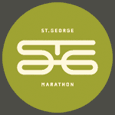St. George Marathon
| St. George Marathon | |
|---|---|
 St. George Marathon | |
| Date | October |
| Location | St. George, Utah |
| Event type | road |
| Distance | Marathon |
| Established | 1977 |
| Official site | http://www.stgeorgemarathon.com/ |
The St. George Marathon is an annual marathon sporting event hosted by the city of St. George, Utah on the first Saturday in October. The first race run was in November 1977. It was originated and organized in just a few months by Sherm Miller, who worked for the Parks and Recreation Department of St. George City. It is currently the 13th largest marathon in the United States of America.
Race
The St. George Marathon accommodates up to 7,400 runners. All runners, male and female, from any nation, may submit registrations to run; but only 7,400 runners are selected by random lottery to participate. Runners must be able to complete the race within six hours.
The race begins at 6:40 AM for wheelchair participants, and at 6:45 AM for runners. The course starts in the scenic Pine Valley Mountains at an altitude of 5,240 feet (1,598m), and descends nearly 2,600 feet (792m) through varied scenery, including the formations of spectacular white, pink, and red sandstone and black basalt in Snow Canyon State Park. The race finishes in Vernon Worthen Park in St. George City at an altitude of 2680 feet (816 m).
Morning temperatures usually range from 38°F to 44°F (3°C to 7°C), while temperatures at the finish typically range from 65°F to 85°F (18°C to 28°C).
History
When Sherm Miller, who worked for the St. George City Parks and Recreation Department, returned to St. George after running the Deseret News Marathon in Salt Lake City, he was inspired to host a marathon in St. George. Although others were not as enthusiastic about the idea, he was allowed to hold his marathon. He quickly organized the first St. George Marathon, held in November 1977.
That first race began on a cold day with 57 runners and one wheelchair racer. The participants faced a strong headwind as they ran. Near mile 20, one runner was almost hit by a hay truck. Of the 58 who started the race, only 38 reached the finish line, a finish line on a course that was later discovered to be 40 yards too short.
The next year the number of participants grew to 378 just by word of mouth, drawn by the descriptions of the scenery of Southwestern Utah, including red and white sandstone formations in the Snow Canyon area just outside St. George, even though the race at that time was not yet a sanctioned marathon.
Since then, the St. George Marathon has grown steadily and has since become a USA Track and Field Certified and Sanctioned race.
In 2006, the 30th anniversary of the St. George Marathon, the race was limited to 6,700 participants, with applicants selected by random lottery, except for residents of Washington County, Utah and members of the St. George Marathon's 10-year and 20-year clubs who are officially entered into the race before the lottery. Also in 2006, the course was changed slightly in the last two miles for the run within the city, providing a route that is less congested with automobile traffic.
The first member of the 10-year club was Debbie Zockoll who ran for the 10th time in 1987. She was also the first member of the 20-year club, and in 2006 she became the first member of the 30-year club, as she was one of those original 58 runners and is the only person to have participated in every St. George Marathon since then (so far).
Race times are used by many participants to qualify for the Boston Marathon.
Runner's World magazine has included the St. George Marathon in the Runner's World 10 Most Scenic Marathons, Fastest Marathons and the Top 20 Marathons in the USA; calling it one of four "marathons to build a vacation around." Based on surveys of runners, Runner's World magazine named the St. George Marathon, the Most Organized Marathon. The race is known for tremendous volunteer support.
The St. George Marathon is currently part of the Utah Grand Slam.
External links
- Official Web site of the St. George Marathon
- St. George Marathon Elevation Profile
- Information about The Mayor's Walk event